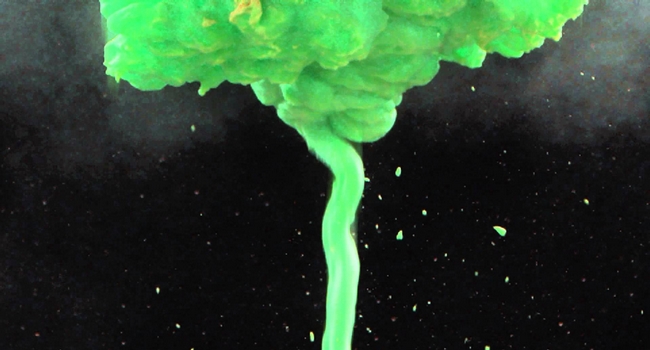20. The Creation – We Are Paintermen (1967)
 The Creation is the most universally lauded of the freakbeat bands, exhibiting an excellence and maintaining an anonymity that is like catnip to rock snobs. Like many of the band’s peers in this junk-drawer genre, The Creation never recorded a proper album. We Are Paintermen was a quickly thrown together hodgepodge of singles and outtakes designed to capitalize on the band’s singular popularity in Germany. It is, nonetheless, an amazing album.
The Creation is the most universally lauded of the freakbeat bands, exhibiting an excellence and maintaining an anonymity that is like catnip to rock snobs. Like many of the band’s peers in this junk-drawer genre, The Creation never recorded a proper album. We Are Paintermen was a quickly thrown together hodgepodge of singles and outtakes designed to capitalize on the band’s singular popularity in Germany. It is, nonetheless, an amazing album.
Eddie Phillips’ guitar work is ruthless, swathed in feedback and drenched with distortion. As the originator of the “violin-bow-on-guitar-strings” gimmick, he exercised more constraint and taste than the usurping Jimmy Page would ever be able to muster. The album is resplendent with the snarling lead vocals, rolling bass, cascading drums and chirping falsetto backing vocals that worked so well for the early Who. Thirty years after the release of this record the stone was finally rolled back and the holy ghost of The Creation was finally revealed to America when the song “Making Time” was featured in Wes Anderson’s classic “Rushmore.”
The coolest song never to be a hit, “Making Time” is a frontal assault of youthful aggression and snotty contempt punctuated by brash staccato guitar chords, syncopated palm-mutes and jittery, nervous percussion. This song piqued the interest of alt-indie kids throughout the States. It hipped them to the idea that there was a long neglected sub-genre lying dormant, waiting to be discovered and explored.
19. The Small Faces – There Are But Four Small Faces (1967)
 For most of the R&B based bands of the British Invasion the requisite transition to psychedelic sound required an ungainly lurching forward. One almost cringes, for example, at the self-consciousness of Eric Burdon & The Animals’ Winds Of Change. The Small Faces, conversely, made the metamorphosis gracefully, without treating its blue-eyed soul beginnings like embarrassing baby photos.
For most of the R&B based bands of the British Invasion the requisite transition to psychedelic sound required an ungainly lurching forward. One almost cringes, for example, at the self-consciousness of Eric Burdon & The Animals’ Winds Of Change. The Small Faces, conversely, made the metamorphosis gracefully, without treating its blue-eyed soul beginnings like embarrassing baby photos.
Once the most mod of the mod bands, The Small Faces started out as a quartet of diminutive, East end, Dexy popping fashion-whores. After a string of stellar singles and regional approbation, the band parted ways with its label, Decca, and manager Don Arden before joining Andrew Loog Oldham’s nascent Immediate label. The band’s first record for Immediate, the second successive one to be self titled, was re-released a while later in the U.S. as There Are But Four Small Faces in the magic summer of ’67.
The Small Faces’ strongest charting single in America, “Itchycoo Park,” opens the set, declaring boldly that although the band had evolved, it hadn’t forgotten where it came from. The song’s splendiferous pastoral arrangement is countered by Steve Marriott’s bluesy growl during a call-and-response chorus. It was yin and yang, flowers and fists. This cross-pollination of trippy and gritty appears recurrently throughout the record, most effectively during “Tin Soldier” as the band seems unable to resist the inertia of each plaintive verse being pulled toward its soul-stomping chorus.
A few tracks belong to one camp or another. “Talk To You” and “Get Yourself Together” are unabashedly Northern soul crossbreeds, while “Up The Wooden Hills To Bedfordshire,” “Green Circles” and the pro-pusher tribute “Here Comes The Nice” are all psyche-pop thoroughbreds. There Are But Four Small Faces is a sterling example of what a band can achieve when they stay true to themselves, both of themselves.
18. The Bee Gees – The Bee Gees 1st (1967)
 Taken individually, the evidentiary facts of the Bee Gees early career should have insured the group’s exclusion from the pantheon of great British Invasion bands. Barry, Robin and Maurice Gibb weren’t, in the strictest sense, even British. They were English émigrés who had become Australian citizens. Many of their songs were overwrought, orchestrally smothered melodrama delivered with Robin’s bleating-sheep vibrato and Barry and Maurice’s adenoidal falsetto harmonies. They had big teeth and they smiled a lot. Most of us, who are old enough, think of the brothers Gibb as the polar opposite of everything that was cool way back in the gob-drenched punk rock summer of ’77.
Taken individually, the evidentiary facts of the Bee Gees early career should have insured the group’s exclusion from the pantheon of great British Invasion bands. Barry, Robin and Maurice Gibb weren’t, in the strictest sense, even British. They were English émigrés who had become Australian citizens. Many of their songs were overwrought, orchestrally smothered melodrama delivered with Robin’s bleating-sheep vibrato and Barry and Maurice’s adenoidal falsetto harmonies. They had big teeth and they smiled a lot. Most of us, who are old enough, think of the brothers Gibb as the polar opposite of everything that was cool way back in the gob-drenched punk rock summer of ’77.
Forget the cute kitsch of the recent disco revival. If you were alive back then, and musically conscious before the Sex Pistols showed up, you were in fucking hell and The Bee Gees were Satan! That’s what makes The Bee Gees 1st (which, oddly, was their third album) such a welcomed surprise for the modern listener. The songs that comprise the record are vibrant, infectious and beautifully arranged with a deft mastery of melodic hooks and harmonics as evidenced in the hit “To Love Somebody.”
The Brothers’ awe of The Beatles is in full display, perhaps too fully as they pilfer liberally from “Strawberry Fields Forever” (“Red Chair, Faid Away”), “Taxman” & “Doctor Robert” (“In My Own Time”) and “Eleanor Rigby” (“New York Mining Disaster 1941”). I would, however, prefer them to lift an idea or two from my favorite band than to have them produce something that makes middle-aged white people dance. All in all, The Bee Gees 1st is a noteworthy contribution to the pop music tradition that the group would, ten years later, all but destroy.
17. The Who – A Quick One (U.S. as Happy Jack) (1966)
 In a decidedly cavalier move, Decca, without any supporting evidence, concluded that all four members of The Who should be writing the band’s material. It made perfect sense. Why rely solely on the talents of Pete Townshend, only 20 and already one of the most gifted songwriters of his generation, when you can bankroll an experiment in egalitarianism?
In a decidedly cavalier move, Decca, without any supporting evidence, concluded that all four members of The Who should be writing the band’s material. It made perfect sense. Why rely solely on the talents of Pete Townshend, only 20 and already one of the most gifted songwriters of his generation, when you can bankroll an experiment in egalitarianism?
Each of the other three were advanced a £500 bonus by the publisher, Essex, to provide two original compositions each for the band’s second album, A Quick One. Bassist John Entwistle scored the highest marks with his likable “Whiskey Man” and the oddball eeriness of what would become a Halloween mix-tape staple, “Boris The Spider.” The other half of rock ‘n’ roll’s greatest rhythm section, Keith Moon, acquitted himself nearly as well. Moon’s drum solo-as-song offering, “I Need You,” was a swipe at The Beatles, with a speaking voice in the background imitating John Lennon, whom he believed talked behind his back using a “secret language” (uh, what?), and an anarchic bit of instrumental tom-foolery called “Cobwebs & Strange.” For Roger Daltry, however, songs passed like kidney stones. His sole submission, “See My Way,” was so horrendous that it wasn’t even mixed in stereo with the rest of the album.
Like a mother lion that had been amusedly watching her cubs paw ineffectually at a meerkat, Townshend decided to show the rest of the band how it was done. His “Run Run Run” and “So Sad About Us” are steeped in the catchy power-chord tradition that defined the band’s earlier singles and the endearingly silly “Happy Jack” (Included in the U.S. release only), which is a frolicsome morality fable that cheerfully ends in suicide. With his dominance within the band fully affirmed, Townshend decided to show off a little bit with a six-part mini-rock-opera. The racily titled “A Quick One While, While He’s Away” is an episodic tale of a lonely girl’s infidelity with a lecherous cockney train engineer and the absolution granted by her returned lover. It was entertaining and fun and presaged bigger things to come. In the future, after this attempt at creative delegation, the Who’s publishers would keep their money and just let Townshend do his thing.
16. The Hollies – Dear Eloise / King Midas In Reverse (1967)
 The Hollies were never given the proper respect, always forced to sit at the kid’s table. Like Herman’s Hermits, or the interchangeable doppelgänger duos of Peter & Gordon or Chad & Jeremy, they were just too freshly scrubbed, too perky, and in 1967 the band suffered the ultimate shame of not being “groovy”.
The Hollies were never given the proper respect, always forced to sit at the kid’s table. Like Herman’s Hermits, or the interchangeable doppelgänger duos of Peter & Gordon or Chad & Jeremy, they were just too freshly scrubbed, too perky, and in 1967 the band suffered the ultimate shame of not being “groovy”.
Discovering, with the release of “Evolution” earlier that year, that it took more than just a trippalicous album cover to placate the freaks, The Hollies delivered the finest album of its career, Butterfly. It was released in the U.S. as Dear Eloise / King Midas In Reverse, wisely omitting the lisp filled goofiness “Pegasus” along with “Try It” and “Elevated Observation,” and adding the flawless “King Midas In Reverse.”
The band’s newly donned Nehru jackets were ill fitting. It was as if The Hollies were members of the A.V. club doing bong-hits with the stoners out behind the bleachers. The record may have done little to assuage The Hollies thirst for hippy legitimacy, but it successfully coupled its trademark three-part harmonies with a new level of experimentation, resulting in a marvel of vibrant pop.
Recorded at the end of the dizzying year of 1967, the album borders on pastiche, flagrantly plagiarizing from the motifs of its peers: The obligatory sitar and tabla Indianism of “Maker”, the wheezing mellotron of “Dear Eloise”, the chirpy Simon & Garfunkel inspired folk-pop of “Wishyouawish,” the quaint Dickensian character study “Charlie & Fred,” the woodwind overdubbing of “Away Away Away” and the lofty symphonics of “Butterfly” could all be found elsewhere. What distinguishes this album, notwithstanding its contrivances, is the accomplished songwriting and unrivaled vocal harmonies of Alan Clarke, Graham Nash and Tony Hicks. Nash, seeking the gravitas he was denied as a Holly was already plotting his elopement with The Byrd’s David Crosby and Buffalo Springfield’s Stephen Stills. His departure ended The Hollies heyday and begat a mediocre, Laurel Canyon, barbershop-folk-rock trio that we could have all lived without.
Be sure to read about records 21-25 and stay tuned for 11-15, 6-10, and 1-5.



